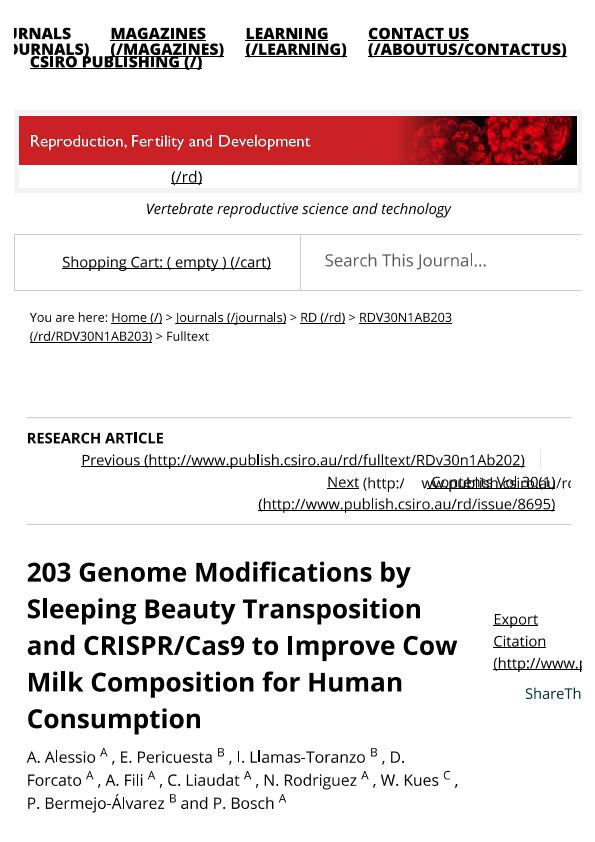Artículo
Genome modifications by sleeping beauty transposition and CRISPR/Cas9 to improve cow milk composition for human consumption
Fecha de publicación:
12/2017
Editorial:
Csiro Publishing
Revista:
Reproduction Fertility and Development
ISSN:
1031-3613
e-ISSN:
1448-5990
Idioma:
Español
Tipo de recurso:
Artículo publicado
Clasificación temática:
Resumen
Genome manipulation of cattle represents a powerful tool to increase the nutritional value and reduce allergenicity of cow milk for human consumption. This could be accomplished by improving the amount of polyunsaturated fatty acids (ω-3 and ω-6) and simultaneously abolishing β-lactoglobulin (BLG), a potent allergen for predisposed humans. The aim of this study was to introduce the sequence for a desaturase construct (mFAT-2, from C. elegans), which is able to catalyse the synthesis of ω-3 and ω-6 fatty acids, into the bovine genome by Sleeping Beauty (SB) transposition, and simultaneously knocking out the bovine β-lactoglubulin gene using CRISPR/Cas9 system. The sgRNA (AAGTGCCTCCTGCTTGCCC) targeted to BLG exon 1 was synthesised as an oligo linker and cloned into the px459-Cas9. The mutation activity of the designed sgRNA at the target locus was determined by T7 endonuclease assay I (T7EI) mismatch detection assay. Briefly, bovine fetal fibroblasts (BFF) were seeded at 0.5 × 105 cells per well of a 24-well plate in triplicate, when the cells reached 80% confluence (12?24 h), cultures were transfected with 1 μg of px459-Cas9::BLG plasmid co-expressing Cas9 and sgRNA using polyethylenimine reagent (PEI; 3 ng μL−1). After 3 days of puromycin selection, genomic DNA from transfected cells were extracted and the sequence of interest was PCR-amplified and digested by T7EI restriction enzyme. Digestion products showed a mutation efficiency at the target locus of 29%. Subsequently, we chemically cotransfected 0.5 × 105 BFF with 0.5 μg of knockout vector (px459-Cas9::BLG) and 0.5 μg of SB plasmids (carrying mFAT-2 cDNA for mammary gland-specific expression) using 3 ng μL−1 PEI in triplicate. At 48 h post-transfection, cell cultures were subjected to 3 days of puromycin and 21 days of neomycin selection. PCR analysis of antibiotic resistant colonies revealed the presence of mFAT-2 transgene in almost 70% of the analysed cells lines. Genotyping of BLG exon 1 was performed by direct sequencing of PCR amplicons using primers flanking the target site. Despite the appreciable gene mutation activity of the sgRNA sequence previously determined by T7EI assay (29%), none of the cell lines analysed showed modification in the BLG target locus. We speculate that the SB vector might have disrupted the activity of targeting vector. We are currently performing additional experiments to accomplish gene addition (mFAT) and gene knockout (BGL) in one step using these highly efficient and precise transgenic tools. Genetically modified cells will be used as nuclear donor to produce transgenic cows by somatic cells nuclear transfer.
Archivos asociados
Licencia
Identificadores
Colecciones
Articulos(CCT - CORDOBA)
Articulos de CTRO.CIENTIFICO TECNOL.CONICET - CORDOBA
Articulos de CTRO.CIENTIFICO TECNOL.CONICET - CORDOBA
Citación
Alessio, Ana Paula; Pericuesta, Eva ; Llamas Toranzo, Ismael; Forcato, Diego Oscar; Bosch, Pablo; Genome modifications by sleeping beauty transposition and CRISPR/Cas9 to improve cow milk composition for human consumption; Csiro Publishing; Reproduction Fertility and Development; 12-2017
Compartir
Altmétricas




